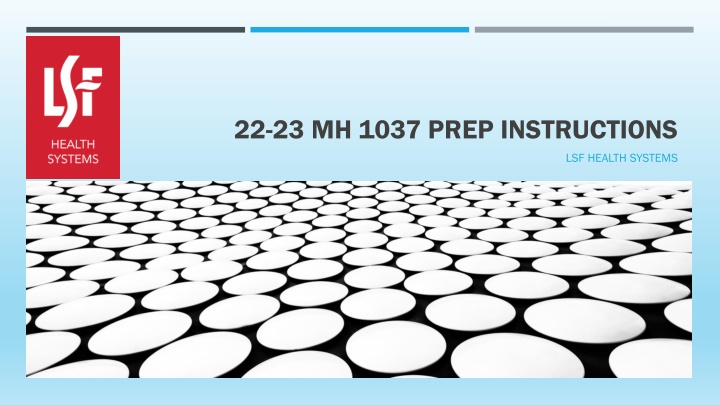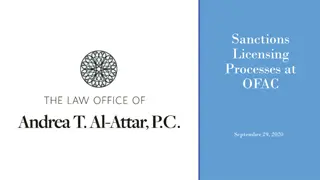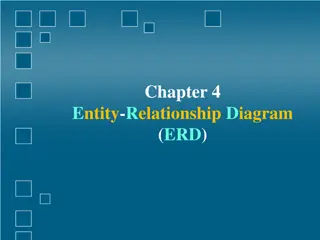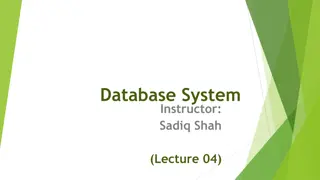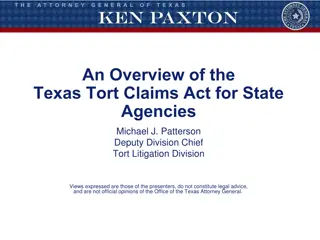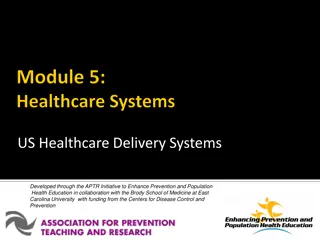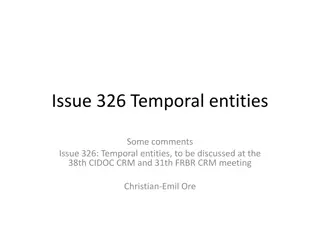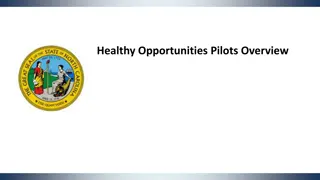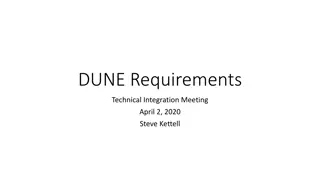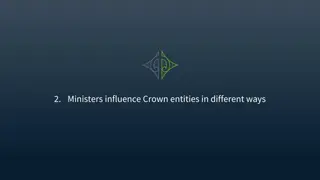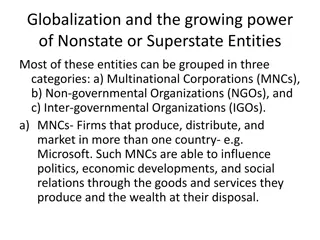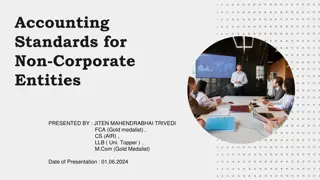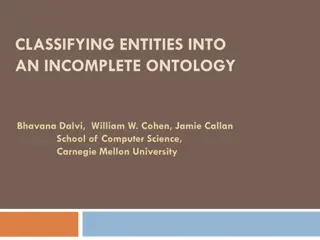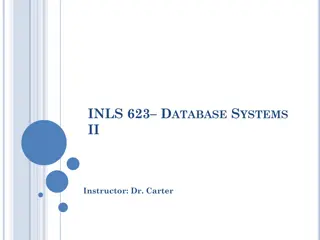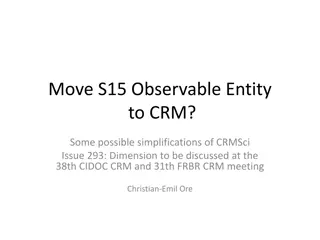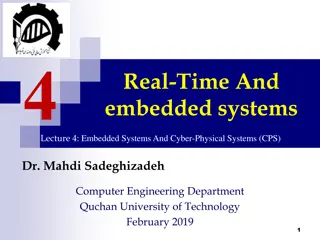Requirements for Managing Entities in Health Systems
Grant agreements and payments of federal and state financial assistance require compliance with specific statutory authorities. Managing entities must follow guidelines for reporting and reconciling funds, with a focus on transparency and accountability. Providers are required to complete specific sections on the CF-MH-1037 forms for revenues and expenses. Any discrepancies must be resolved promptly and reported as necessary. The form CF-MH-1037 is essential for audits and submissions to managing entities, ensuring accurate tracking of funds allocated for substance abuse and mental health services.
Download Presentation

Please find below an Image/Link to download the presentation.
The content on the website is provided AS IS for your information and personal use only. It may not be sold, licensed, or shared on other websites without obtaining consent from the author.If you encounter any issues during the download, it is possible that the publisher has removed the file from their server.
You are allowed to download the files provided on this website for personal or commercial use, subject to the condition that they are used lawfully. All files are the property of their respective owners.
The content on the website is provided AS IS for your information and personal use only. It may not be sold, licensed, or shared on other websites without obtaining consent from the author.
E N D
Presentation Transcript
22-23 MH 1037 PREP INSTRUCTIONS LSF HEALTH SYSTEMS
STATUTORY AUTHORITY (WHY) All grant agreements and payments of Federal and State financial assistance require compliance with: Section 215.971, Florida Statutes (F.S.), subsection 215.971 (2)(c), F.S. Final reconciliation report must identify any funds paid in excess of the expenditure. State or Federal funds paid to the provider in excess of documented allowable expenditures must be returned to the state unless otherwise authorized by law. Agreements with recipients of State Financial Assistance, even if awarded on a fixed price basis, must require: Compliance with Section 215.97, F.S. (Single Audit Act) Compliance with Section 215.971, F.S.- (Agreements funded with Federal or State assistance) Agreements (sub-awards) with sub-recipients of Federal Financial Assistance require compliance with: Uniform Administrative Requirements, Cost Principles and Audit Requirements for Federal Awards (also known as the Uniform Guidance), Code of Federal Regulations Title 2, Part 200 (2 CFR, Part 200). Any balance of unobligated cash that has been advanced or paid that is not authorized to be retained for other projects must be refunded to the federal government.
REQUIREMENTS (WHAT) MANAGING ENTITIES (MEs) MANAGING ENTITIES (MEs) Each SAMH provider must be given the total paid by Other Cost Accumulator (OCA) for each covered service and program project code, in addition to the Post Award Notice at the end of the year. Any discrepancies identified should be resolved expeditiously so necessary adjustments can be made and reported to DCF, if necessary. The CF-MH 1037 total revenues by covered services and project codes within each program received from MEs. This form must match the final expenditure reports submitted to DCF. PROVIDERS PROVIDERS Substance Abuse (SA) and Mental Health (MH) entities (Providers) must use the form CF-MH 1037, as prescribed by rule FAC 65E-14, for the supplemental schedule in their annual audits and for submissions to MEs. Form CF-MH 1037 requires the period to be on a July 1st through June 30th basis. If Mental Health and Substance Abuse services are provided, both program must be displayed separately on form CF-MH 1037, due to state appropriation and federal grant funding for each program as they both are different. Form CF-MH 1037 should be used as the supplemental schedule with the annual CPA Audit, post reconciliation. Any adjustments to the form identified by auditors or providers post reconciliation, should be communicated forthwith to the appropriate ME, disclosing the nature and requirement of the adjustment to determine the effect on the final reconciliation. MEs should report adjustments and justification to DCF. Form CF-MH 1037 is required even if the single audit threshold of $750,000 is not met.
REQUIREMENTS (WHAT) Please do not adjust any State revenue numbers in your 1037 forms. Only complete the categories referenced below. FOR PROVIDERS: FOR PROVIDERS: Providers are required to complete the following sections on their MH -1037 forms. For Revenues: For Revenues: Section IB: Other Government Funding by categories listed in the form.. Section IC: All other revenues by categories listed in the form.
REQUIREMENTS (WHAT) FOR PROVIDERS: FOR PROVIDERS: Providers are required to complete the following sections on their MH -1037 forms. For For Expens Expenses: es: Section IIA: Personnel Expenses by categories listed in the form, Section IIB: All other expenses by categories listed in the form. Section IIC: Distributed indirect costs by Support and Administration. Section IID: Unallowable costs (if any) Section IIE: Capital Expenditures (if any) Please include ALL EXPENSES ALL EXPENSES by each category & covered svc.
TIMELINE (WHEN) October 31 October 31 : : Provider 1037 s sent out December December 15 or before 15 or before: : 1037 s due to LSF from Providers December 16 through 31 December 16 through 31 : : LSF s Review of 1037s submitted by providers and reallocation (if any) by LSF. 1037 s will be sent back to providers once reallocation is complete for final review and approval. Review and discussion of reallocations submitted by LSF for approval by providers.
SCENARIOS (HOW) Assumption Assumption Scenario Scenario Example Example Surplus of funds in each covered service. Surplus of funds in each covered service. State funding does not exceed allowable State funding does not exceed allowable expenses but addition of other sources of expenses but addition of other sources of revenue take revenues higher than expenditures. revenue take revenues higher than expenditures. $800K in state funds, $600K in other Revenues, equals $1,.4M in total funding. $1M in expenditures. Provider does not have a payback. Please see example 1. Provider can apply all allowable expenses to state funding "first . For each OCA, funding can be moved to any other covered service that used that same OCA, up to the total allowable expenses for the covered service. State funding exceeds allowable expenses for a State funding exceeds allowable expenses for a given covered service. given covered service. Please see example 2 More than one OCA are spent on the given More than one OCA are spent on the given covered services. covered services. Provider's discretion to be applied on payback (if any) from each OCA. Please see examples 3 & 4. State funding can be applied to all allowable expenses. In other words, none of the other funding would be considered when calculating provider payback. Other funding sources are included in the Other funding sources are included in the covered service. covered service. Please see example 5 Over-earning reallocated between allowable OCAs and reallocation not possible within 1 OCA and Covered Service due to over-earning. Reallocation & Payback Reallocation & Payback Please see example 6
SCENARIOS (HOW) Example 1: Provider SAMH Funding: $800,000 over 3 different OCAs Provider Other Revenues: $600,000 Total Revenues: $1,400,000 Total Expenses: $1,000,000 Result: No Payback as provider Result: No Payback as provider expenses exceed total SAMH funding. expenses exceed total SAMH funding. $800,000 less $1,000,000 = ($200,000) over earned.
SCENARIOS (HOW) Example 2: State funding for SAMH under 2 covered services: $300,000 for Case Management and $500,000 for Crisis Support/Emergency in the same OCA MH0CN Example 2: Total expenses under both covered services: $200,000 for case management and $800,000 for Crisis Support/Emergency Provider SAMH Funding: $500,000 Provider Other Revenues: $600,000 Result: Under-earned (Surplus) in Case Management and Over-earned (Deficit) in Crisis Support/Emergency Total Funding: $1,100,000 Total Expenses: $1,000,000 Result: No Payback as provider expenses exceed total SAMH fundin Net Result: No payback as reallocation Net Result: No payback as reallocation possible between covered services possible between covered services under the same OCA MH0CN under the same OCA MH0CN.
Example 3: SCENARIOS (HOW) State funding for SAMH under 3 covered services: $300,000 for Case Management, $300,000 for Crisis Stabilization and $500,000 for Crisis Support/Emergency in 2 different OCAs MH009 & MH018 Total expenses under all 3 covered services: $400,000 for case management, $300,000 for Crisis Stabilization and $400,000 for Crisis Support/Emergency Example 2: Provider SAMH Funding: $500,000 Result: Over-earned (Deficit) in Case Management, Breakeven in Crisis Stabilization and Under-earned (Surplus) in Crisis Support/Emergency in 2 different OCAs. Provider Other Revenues: $600,000 Net Result: No payback as reallocation possible Net Result: No payback as reallocation possible even if they are in 2 different covered services and 2 even if they are in 2 different covered services and 2 different OCAs. Please refer to Instructions tab in different OCAs. Please refer to Instructions tab in your 1037 form under section IIIB. your 1037 form under section IIIB. Total Funding: $1,100,000 Total Expenses: $1,000,000 Result: No Payback as provider expenses exceed total SAMH funding.
SCENARIOS (HOW) Example 4: State funding for SAMH spread over multiple covered services but between 3 OCAs, MS003, MS011 and MS021 Expenses exceed revenues for 2 covered services and do not for 1 covered services. Example 2: Since we are allowed to reallocate funds between MS000 OCAs i.e., MS003 and MS021 as illustrated in the above slide for multiple covered services. Provider SAMH Funding: $500,000 Provider Other Revenues: $600,000 Net Result: No payback as reallocation Net Result: No payback as reallocation possible even if they are in multiple possible even if they are in multiple covered services and 3 different OCAs. covered services and 3 different OCAs. Total Funding: $1,100,000 Total Expenses: $1,000,000 Please refer to instructions tab in your 1037 form under section IIIB. Result: No Payback as provider expenses exceed total SAMH funding.
SCENARIOS (HOW) Example 5: State funding for SAMH in 2 covered services and 2 OCAs for $350,000 and $450,0000 respectively. All other revenues recorded in Sections IB and IC. Example 2: Expenses for the 2 covered services recorded as $500,000 and $300,000 respectively. Provider SAMH Funding: $500,000 Provider Other Revenues: $600,000 Net Result: No other revenue sources Net Result: No other revenue sources from Section IB and IC are included in from Section IB and IC are included in the calculation for unearned funds as the calculation for unearned funds as evident. evident. $350,000 less $500,000 = $150,000 $350,000 less $500,000 = $150,000 over over- -earned (deficit) earned (deficit) Total Funding: $1,100,000 Total Expenses: $1,000,000 $450,000 less $300,000 = $150,000 $450,000 less $300,000 = $150,000 under under- -earned (surplus) earned (surplus) Result: No Payback as provider expenses exceed total SAMH funding.
Example 6: Example 6: State funding for SAMH in 3 covered services and 3 OCAs for $350,000, $450,0000 and $500,000, respectively. SCENARIOS (HOW) All other revenues recorded in Sections IB and IC. Expenses for the 3 covered services recorded as $500,000, $300,000, $300,000 respectively. Example 2: Net Result: Net Result: $350,000 less $500,000 = $150,000 over $350,000 less $500,000 = $150,000 over- - earned (deficit) in Case Management. earned (deficit) in Case Management. Provider SAMH Funding: $500,000 $450,000 less $300,000 = $150,000 under $450,000 less $300,000 = $150,000 under- - earned (surplus) in Crisis Stabilization. earned (surplus) in Crisis Stabilization. Provider Other Revenues: $600,000 $500,000 less $300,000 = $200,000 $500,000 less $300,000 = $200,000 Under Under- -earned (surplus) in Crisis Support earned (surplus) in Crisis Support Emergency. Emergency. Total Funding: $1,100,000 Reallocation possible between Case Reallocation possible between Case Management and Crisis Stabilization because Management and Crisis Stabilization because of allowable OCAs (MS011 and MS021) of allowable OCAs (MS011 and MS021) leading to leading to NO PAYBACK NO PAYBACK. . Total Expenses: $1,000,000 Result: No Payback as provider expenses exceed total SAMH funding. Reallocation NOT possible due to funding in Reallocation NOT possible due to funding in only one OCA (MSARP) and one Covered only one OCA (MSARP) and one Covered Service Service - - Crisis Support Emergency leading to Crisis Support Emergency leading to a a PAYBACK PAYBACK of $200,000. of $200,000.
1037 QUICK GUIDE Each section below must be completed. Expenses Expenses Revenues Revenues (By covered service) Expenditures reported should: cover from July 1st, 2022 through June 30th, 2023. be separated by Mental Health & Substance Abuse covered services. include ALL services. ALL your expenditures reported by covered The amounts reported on your 1037 reconciliation The amounts reported on your 1037 reconciliation should match your audited financials. should match your audited financials. IID: Unallowable costs (if any) IID: Unallowable costs (if any) IIE: Capital Expenditures (if any) IIE: Capital Expenditures (if any)
Q & A SESSION For additional questions or concerns, please send an email to grantsjax@lsfnet.org or call us at (904) 337 4055.
